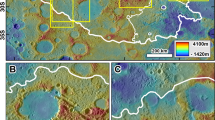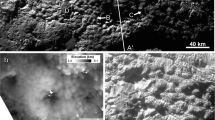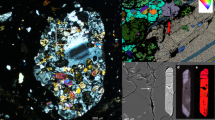Abstract
The most heavily cratered terrains on Mercury have been estimated to be about 4 billion years (Gyr) old1,2,3,4, but this was based on images of only about 45 per cent of the surface; even older regions could have existed in the unobserved portion. These terrains have a lower density of craters less than 100 km in diameter than does the Moon1,3,5, an observation attributed to preferential resurfacing on Mercury. Here we report global crater statistics of Mercury’s most heavily cratered terrains on the entire surface. Applying a recent model for early lunar crater chronology6and an updated dynamical extrapolation to Mercury7, we find that the oldest surfaces were emplaced just after the start of the Late Heavy Bombardment (LHB) about 4.0–4.1 Gyr ago. Mercury’s global record of large impact basins8, which has hitherto not been dated, yields a similar surface age. This agreement implies that resurfacing was global and was due to volcanism, as previously suggested1,5. This activity ended during the tail of the LHB, within about 300–400 million years after the emplacement of the oldest terrains on Mercury. These findings suggest that persistent volcanism could have been aided by the surge of basin-scale impacts during this bombardment.
This is a preview of subscription content, access via your institution
Access options
Subscribe to this journal
Receive 51 print issues and online access
$199.00 per year
only $3.90 per issue
Buy this article
- Purchase on Springer Link
- Instant access to full article PDF
Prices may be subject to local taxes which are calculated during checkout



Similar content being viewed by others
References
Strom, R. G. Origin and relative age of lunar and Mercurian intercrater plains. Phys. Earth Planet. Inter. 15, 156–172 (1977)
Leake, M. A. The Intercrater Plains of Mercury and the Moon: their Nature, Origin, and Role in Terrestrial Planet Evolution. PhD thesis, Univ. of Arizona. (1982)
Strom, R. G. & Neukum, G. in Mercury (eds Vilas, F., Chapman, C. R. & Matthews, M. S. ) 336–373 (Univ. Arizona Press, 1988)
Neukum, G., Oberst, J., Hoffmann, H., Wagner, R. & Ivanov, B. A. Geologic evolution and cratering history of Mercury. Planet Space Sci. 49, 1507–1521 (2001)
Fassett, C. I. et al. The global population of large craters on Mercury and comparison with the Moon. Geophys. Res. Lett. 38, L10202 (2011)
Morbidelli, A. et al. A sawtooth-like timeline for the first billion years of lunar bombardment. Earth Planet. Sci. Lett. 355–356, 144–151 (2012)
Marchi, S. et al. A new chronology for the Moon and Mercury. Astron. J. 137, 4936–4948 (2009)
Fassett, C. I. et al. Large impact basins on Mercury: global distribution, characteristics, and modification history from MESSENGER orbital data. J. Geophys. Res.. 117, E00L08, http://dx.doi.org/10.1029/2012JE004154 (2012)
Wilhelms, D. E. Mercurian volcanism questioned. Icarus 28, 551–558 (1976)
Strom, R. G. et al. Mercury crater statistics from MESSENGER flybys: implications for stratigraphy and resurfacing history. Planet. Space Sci. 59, 1960–1967 (2011)
Shoemaker, E. M. et al. Interplanetary correlation of geologic time. Adv. Astronaut. Sci. 8, 70–89 (1963)
Hartmann, W. K. et al. in Basaltic Volcanism on the Terrestrial Planets (eds McGetchin, T. R., Pepin, R. O. & Phillips, R. J. ) 1049–1127 (Pergamon, 1981)
Neukum, G. & Ivanov, B. A. in Hazards Due to Comets and Asteroids (eds Gehrels, T., Matthews, M. S. & Schumann, A. ) 359–416 (Univ. of Arizona Press, 1994)
Stöffler, D. & Ryder, G. Stratigraphy and isotope ages of lunar geologic units: chronological standard for the inner Solar System. Space Sci. Rev. 96, 9–54 (2001)
Strom, R. G. et al. Mercury cratering record viewed from MESSENGER’s first flyby. Science 321, 79–81 (2008)
Head, J. W. et al. Flood volcanism in the northern high latitudes of Mercury revealed by MESSENGER. Science 333, 1853–1856 (2011)
Mainzer, A. et al. NEOWISE observations of near-Earth objects: preliminary results. Astrophys. J. 743, 156–173 (2011)
Le Feuvre, M. & Wieczorek, M. A. Nonuniform cratering of the Moon and a revised crater chronology of the inner Solar System. Icarus 214, 1–20 (2011)
Strom, R. G. et al. The origin of planetary impactors in the inner Solar System. Science 309, 1847–1850 (2005)
Marchi, S. et al. The onset of the lunar cataclysm as recorded in its ancient crater populations. Earth Planet. Sci. Lett. 325, 27–38 (2012)
Crater Analysis Techniques Working Group. Standard techniques for presentation and analysis of crater size-frequency data. Icarus 37, 467–474 (1979)
Wilhelms, D. E. The Geologic History of the Moon (US Geological Survey Professional Paper 1348, 1987)
Hartmann, W. K. Does crater ‘saturation equilibrium’ occur in the solar system? Icarus 60, 56–74 (1984)
Bottke, W. F. et al. Debiased orbital and absolute magnitude distribution of the near-Earth objects. Icarus 156, 399–433 (2002)
Bottke, W. F. et al. An Archaean heavy bombardment from a destabilized extension of the asteroid belt. Nature 485, 78–81 (2012)
Fassett, C. I. et al. Lunar impact basins: stratigraphy, sequence and ages from superposed impact crater populations measured from Lunar Orbiter Laser Altimeter (LOLA) data. J. Geophys. Res. 117, E00H06, http://dx.doi.org/10.1029/2011JE003951 (2012)
Hiesinger, H., Head, J. W., Wolf, U., Jaumann, R. & Neukum, G. in Recent Advances and Current Research Issues in Lunar Stratigraphy (eds Ambrose, W. A. & Williams, D. A. ) 1–51 (Geological Society of America Special Paper 477, 2011)
Marchi, S. et al. The effects of the target material properties and layering on the crater chronology: the case of Raditladi and Rachmaninoff basins on Mercury. Planet. Space Sci. 59, 1968–1980 (2011)
Smith, D. E. The equatorial shape and gravity field of Mercury from MESSENGER flybys 1 and 2. Icarus 209, 88–100 (2010)
Elkins-Tanton, L. T. & Hager, B. H. Giant meteoroid impacts can cause volcanism. Earth Planet. Sci. Lett. 239, 219–232 (2005)
Ivanov, B. A. & Melosh, H. J. Impacts do not initiate volcanic eruptions: eruptions close to the crater. Geology 31, 869–872 (2003)
Acknowledgements
The contributions of S.M. and W.F.B. were supported by the NASA Lunar Science Institute (Center for Lunar Origin and Evolution at the Southwest Research Institute in Boulder, Colorado—NASA Grant NNA09DB32A; Center for Lunar Science and Exploration at the Lunar and Planetary Institute in Houston, Texas). S.M. is grateful for being welcomed as a collaborator with the Geology Discipline Group of MESSENGER. C.R.C.’s contribution was supported by the MESSENGER Project. The MESSENGER Project is supported by the NASA Discovery Program under contracts NASW-00002 to the Carnegie Institution of Washington and NAS5-97271 to the Johns Hopkins University Applied Physics Laboratory.
Author information
Authors and Affiliations
Contributions
S.M. and C.R.C. performed the new crater measurements. S.M. and W.F.B. computed the impact rates. C.I.F., J.W.H. and R.G.S. provided earlier crater catalogues. All authors contributed to a discussion of the results and their implications, and to writing and revising the manuscript.
Corresponding author
Ethics declarations
Competing interests
The authors declare no competing financial interests.
Supplementary information
Supplementary Information
This file contains Supplementary Text, Supplementary Figures1-4, Supplementary Table 1 and additional references. (PDF 1017 kb)
Rights and permissions
About this article
Cite this article
Marchi, S., Chapman, C., Fassett, C. et al. Global resurfacing of Mercury 4.0–4.1 billion years ago by heavy bombardment and volcanism. Nature 499, 59–61 (2013). https://doi.org/10.1038/nature12280
Received:
Accepted:
Published:
Issue Date:
DOI: https://doi.org/10.1038/nature12280
This article is cited by
-
Less than one weight percent of graphite on the surface of Mercury
Nature Astronomy (2024)
-
Widespread small grabens consistent with recent tectonism on Mercury
Nature Geoscience (2023)
-
Gravity evidence for a heterogeneous crust of Mercury
Scientific Reports (2023)
-
Volcanism in the Solar System
Science China Earth Sciences (2023)
-
A model of crust–mantle differentiation for the early Earth
Acta Geochimica (2022)
Comments
By submitting a comment you agree to abide by our Terms and Community Guidelines. If you find something abusive or that does not comply with our terms or guidelines please flag it as inappropriate.



